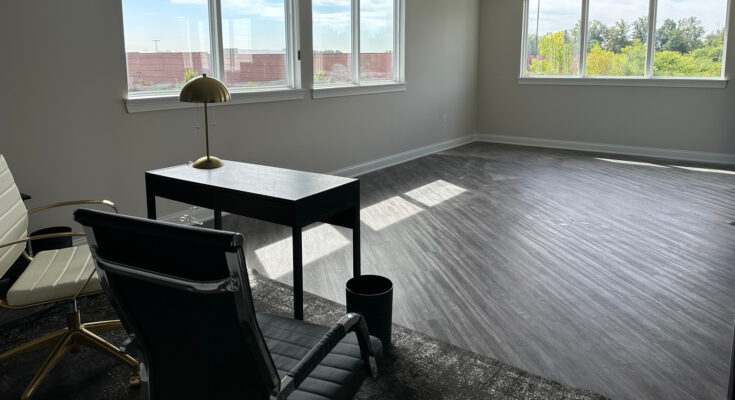Is LVP Flooring Toxic? Here Is What Our Expert Says
There are multiple reasons to install luxury vinyl plank (LVP) flooring in your home. Most notably, the materials are cost-effective, last long, and resist water damage. Better yet, they can mimic the look of natural stone, tiles, and hardwood. In fact, this flooring choice pairs well with a modern farmhouse aesthetic.
Still, when something seems too good to be true, you should pay attention to the finer details. For instance, if you look closely at the manufacturing process of LVP flooring, you’d know that they’re often toxic for you and the environment. To dive deeper into this and understand their potential harm, House Digest spoke exclusively to Ryan Blaser, B.S., E.E., EMRS, BBEC, HAAC, and the founder of Test My Home.
“LVP is typically made from multiple layers of synthetic materials, primarily polyvinyl chloride (PVC),” he told us, shedding light on how LVP flooring is manufactured. “The core is usually made from a composite of PVC resins and fillers, topped with a photographic film layer (for appearance) and a clear wear layer. To make the product flexible and durable, manufacturers often use plasticizers, stabilizers, and other chemical additives.” This is alarming because the chemicals can off-gas and lower your house’s indoor air quality, causing health complications. “Yes, LVP can contain toxins, especially those related to the PVC manufacturing process,” Blaser said. But what are they?
What toxins does LVP flooring contain, and are they potentially harmful?
LVP flooring contains a myriad of chemicals, with volatile organic compounds (VOCs) being the most toxic of the lot by degrading the quality of indoor air. Ryan Blaser elaborated on this further in his exclusive interview with House Digest. “LVP flooring can emit VOCs such as phthalates, formaldehyde, and sometimes heavy metals like lead and cadmium depending on the source materials and manufacturing practices,” he explained. “Phthalates are common plasticizers that are endocrine disruptors, linked to developmental and reproductive issues,” he continued. Although they make the material more flexible, they can have long-term impacts on your health. “Formaldehyde, although less common in newer LVP, is a known carcinogen and respiratory irritant,” Blaser added.
That’s not all. Blaser noted that poor-quality LVP flooring also contains “heavy metals, sometimes found in dyes or stabilizers, [which] are toxic with long-term exposure.” Cadmium and lead are specifically harmful for kids and expecting women. Considering these effects, the government has marked vinyl as a risky material to have indoors. “The CDC [Centers for Disease Control and Prevention], EPA [Environmental Protection Agency], and Agency for Toxic Substances and Disease Registry (ATSDR) have issued guidance on indoor air quality risks from materials like vinyl,” Blaser explained.
There’s also hard evidence of the harmful impacts of LVP flooring. “One study from the Journal of Exposure Science & Environmental Epidemiology (2014) found elevated phthalate levels in homes with vinyl flooring,” Blaser noted. This is especially concerning since the indoor environments of 239 children were considered for this report. And although the majority of off-gassing (gases being released into the air) happens during the manufacturing stage, Blaser noted that “some chemicals, like phthalates, can continue to leach out over time, especially with heat or heavy wear.”
How can you choose safer LVP flooring options
LVP flooring doesn’t just cause headaches (literally) during manufacturing. It’s a pain to dispose of, too. This is because it’s quite expensive to recycle and is often burned at the end of its life cycle. That being said, not all such flooring is the same. If vinyl plank flooring is right for your space, you can still choose relatively safer options to keep your family safe from the harmful off-gassing.
In his exclusive interview with House Digest, Ryan Blaser suggested looking for options that are FloorScore® or GREENGUARD Gold Certified (meaning they were tested for low chemical emissions). Ones marked “phthalate-free” or labeled “non-toxic”” are good choices, too. Moreover, you should opt for flooring made in the United States or European Union (EU), since chemical regulations are stricter in these countries (avoid the ones manufactured in places like China). These precautions will also help you enjoy the long-term effects of vinyl flooring on home resale value.
So what’s the alternative? “We recommend looking for third-party certifications and avoiding off-brand or ultra-low-cost imports, which are more likely to contain harmful chemicals,” Blaser said. In other words, look for LVP flooring from trusted brands because they usually boast a higher quality and go through more stringent checks. If you already have such floors at home, you can test for VOCs and semi-volatile organic compounds (SVOCs) with air sampling. Passive badges are one option — Blaser says they detect airborne chemicals over 24–72 hours. Otherwise, he recommends taking a “surface dust testing for phthalates and flame retardants.” A simple “lab analysis of flooring material (off-gas chamber testing)” will also clue you in on their quality and whether or not they give off toxins.

